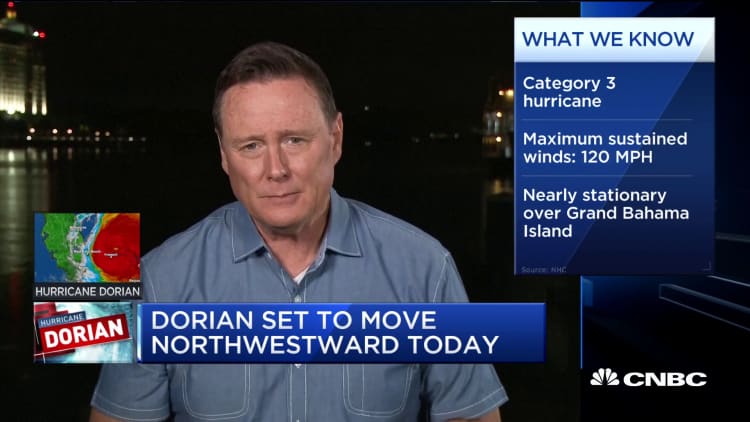
Hurricane Dorian, one of the most powerful Atlantic hurricanes on record, showed some signs of weakening early on Tuesday as it remained stalled over Grand Bahama Island, the Miami-based National Hurricane Center (NHC) said.
Dorian has been pounding the Bahamas for days, killing at least five people in the Abaco Islands in the northern Bahamas and inundating homes with floodwater ahead of its expected advance on the U.S. coast, where more than a million people have been ordered evacuated.
The hurricane has weakened to a Category 3 on the five-step Saffir-Simpson Wind Scale with maximum sustained winds of 130 miles per hour (215 kph), the NHC said early on Tuesday. It is expected to stay put until at least later in the morning.
"We are in the midst of a historic tragedy in parts of our northern Bahamas," Bahamian Prime Minister Hubert Minnis told a news conference on Monday. "Our mission and focus now is search, rescue and recovery."
He added that the U.S. Coast Guard was on the ground in Abaco and had rescued a number of injured individuals. Critically injured people were being taken to hospitals on New Providence, the country's most populous island.
After making landfall in Abaco on Sunday, the hurricane's movement slowed until it was "nearly stationary" Monday as it thrashed Grand Bahama Island, the National Weather Service said.
Earlier winds had reached as much as 220 miles per hour, matching the strongest Atlantic hurricane ever to make landfall, according to the Associated Press. Maximum sustained winds weakened to 145 mph by Monday afternoon, the National Hurricane Center said. The hurricane was causing extreme destruction, with storm surges 18 to 23 feet above normal levels.
Videos shared from the Bahamas showed waves surging across the airport in Freeport, Bahamas. Furniture floated in houses inundated with water.
Cars sat mostly submerged as wind whipped around them, and some locals navigated streets in boats, according to images and videos shared by state-owned broadcaster ZNS Bahamas.
"From all accounts we have received catastrophic damage," Foreign Minister Darren Henfield told ZNS. "We have reports of casualties, we have reports of bodies being seen. We cannot confirm those reports until we go out and have a look for ourselves."
Henfield was speaking from Abaco, where the International Red Cross estimates nearly 13,000 homes may have been severely damaged or destroyed. The group said fresh water will become an important need due to the contamination from saltwater as a result of the extensive flooding.
Residents of parts of Florida, Georgia and South Carolina evacuated as they prepared for the storm's approach. The states' governors ordered at least a million people to evacuate starting Monday, according to NBC News.
Georgia's government estimates the mandatory evacuation orders affect 400,000 people in the state. The orders focus on six coastal counties in Georgia.
Mandatory evacuation orders were in effect starting at noon in eight coastal counties in South Carolina. Gov. Henry McMaster also called for schools and government offices in those counties to close, starting Tuesday.
The NHC expects "life-threatening" storm surges and "hurricane-force winds" along parts of Florida's cost through the middle of the week, it said Monday morning. It forecasts that Dorian will move "dangerously close" to Florida's east coast late Tuesday through Wednesday evening, then creep toward the Georgia and South Carolina coasts by Wednesday night and into Thursday.
President Donald Trump issued disaster declarations Sunday for Georgia and South Carolina, authorizing federal assistance for hurricane relief. He previously took the same step for Florida.
Both the Palm Beach and Fort Lauderdale airports in Florida were closed Monday as Dorian moved closer to the coast. The Orlando International Airport also said it would stop operations on Tuesday.
Meanwhile, the South Carolina Ports Authority's marine terminals in Charleston and Georgetown plan to close Wednesday and Thursday, and reopen on Friday.
As Dorian threatened the southeastern states, officials such as Sen. Marco Rubio, R-Fla., urged residents to listen to the evacuation orders.
From an economic standpoint, the damage has just begun and comes during the summer-ending Labor Day holiday, adding another dimension to the potential dollar cost. UBS already has estimated the cost at around $25 billion.
"That lost economic activity from business closures, canceled travel plans and disruptions in tourism activity during the Labor Day holiday, as people took precautions ahead of the storm, will weigh on real GDP growth for the quarter," Beth Ann Bovino, U.S. chief economist for S&P Global Ratings, said in a note. "Estimating how much depends on where the hurricane makes landfall, at what Category strength, and how long it hangs around dumping water on the region."
S&P has estimated that as climate change accelerates, the cost "doing nothing" could range between 2.2% and 5.2% of GDP by 2021, though the current pace of storm damage suggests that the upper end of the range is more likely.
As the damage mounts, the National Weather Service ramped up its storm updates. The service issued surge warnings for the east cost of Florida and north along the Georgia coast to the Savannah River.
—Reuters contributed to this report.



